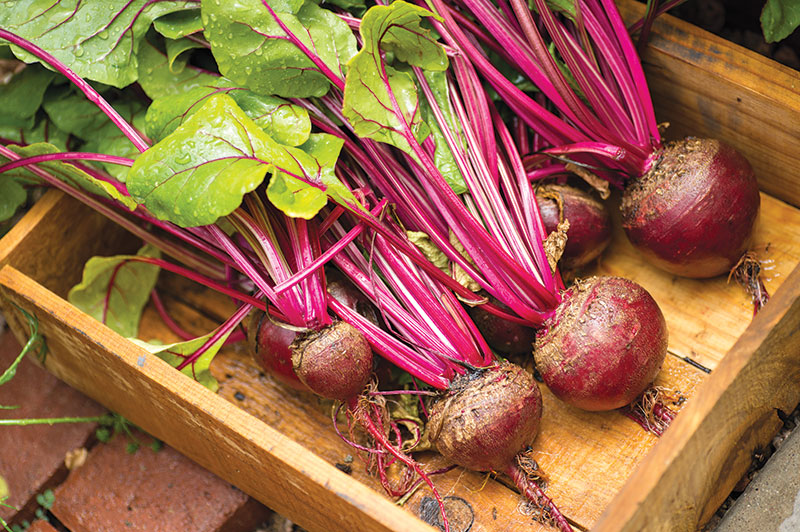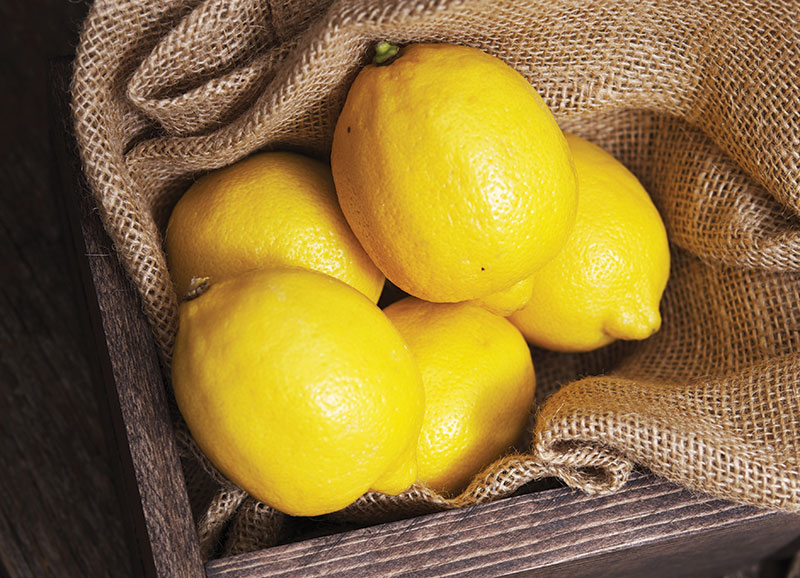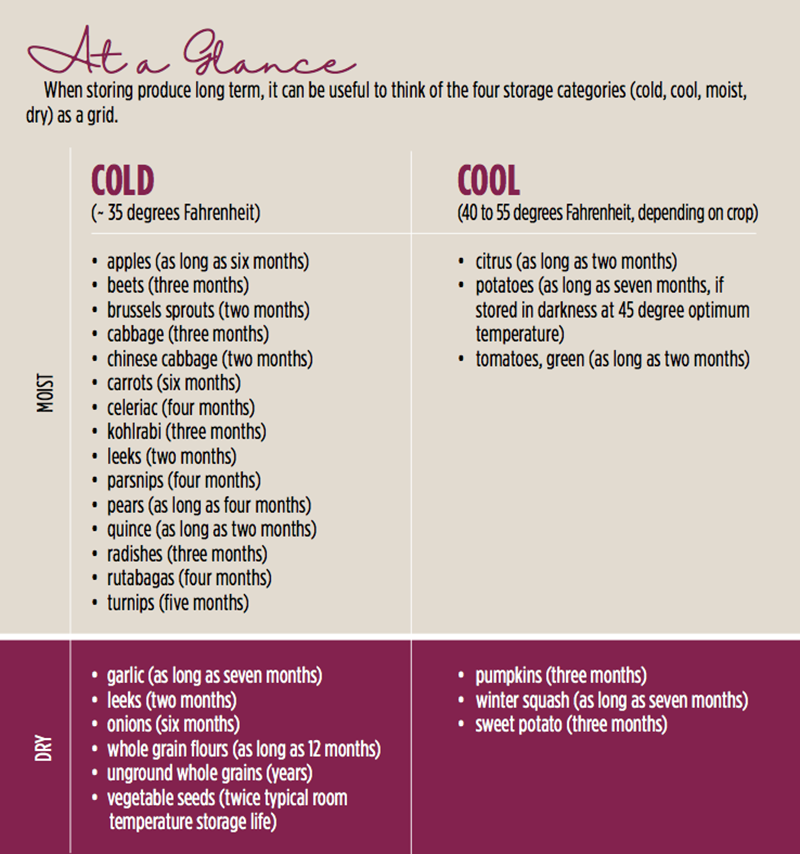
Years ago, before I started urban homesteading, I saw a few adorable, pocket-sized pears for sale at the grocery store. They were packaged up in a plastic, snap-together box, six baby pears in a clamshell. I bought a box and brought them home, excited to try this fun, petite pear.
They were the most grainy, insipid, pointless pears I’d ever eaten. I choked down the first bite and did not go back for a second. I live in Washington, the largest pear-producing state in the U.S., and I’d never experienced pears like that before. Turning over the plastic box, I saw it: “Product of Argentina.”
Before a global food distribution system made it possible to ship rock-hard peaches and unripe plums from South America to South Dakota in January, people stocked their pantries and root cellars with enough locally grown storage crops to see them through the harshest of winters.
Imagine your own private larder stocked with storage fruits and vegetables — apples, pears, squashes, brassicas and roots. Imagine knowing where and how your cold-weather crops were grown and stored between farm and table.
There are many reasons to revive the root cellar. I grow and store my own produce to save money, increase my food security and decrease food miles, and because the flavors of locally grown, fresh-picked crops are just superior to out-of-season imports.
My neighbor doesn’t garden much, but every year she buys several hundred pounds of winter squash from a local farm. She gets a great price and knows that when the weather gets chilly and she wants to make butternut squash soup, she can. She learned the hard way one year that many grocers simply stop selling winter squash after Thanksgiving.
It seems silly to buy flavorless fruits and vegetables that have more frequent flier miles than you do, when with only a little work, you can build a living larder of storage crops at home.
What Can You Store?
Certain fruits and vegetables are better adapted to root cellar storage than others. Typically, produce with a tough skin and dense flesh store best. Produce intended for root cellar storage should mature as late in fall as weather allows without risking damage to the crop, so as to maximize longevity in storage.
Many root vegetables are ideal for cellar storage — roots or tubers are themselves energy storage for the plant. Some well-cured winter squash can last nearly a year in storage. Certain varieties of alliums have been bred to have incredible storage longevity, and with proper care, the right varieties of cabbage-family crops will last months in good condition.
Apples, pears and quince are the classic storage fruit, but citrus does well, too.
Roots & Tubers

Of the classic winter storage items, here are some of the best.
- Beets: Most varieties of beets (pictured above) do well in storage, but Lutz is known for its keeping qualities. Select large, dense, unblemished beets. Wipe off excess soil and trim tops before storing. Beets can last three months in proper storage.
- Carrots: Bolero and scarlet keeper store as long as six months from a fall harvest. Select medium-large, dense roots without any sign of insect damage or blemishes that would lead to rot. Wipe off excess soil and trim tops before storing.
- Celeriac: Brilliant can be stored as long as four months. Trim of roots and leaves and wipe off excess soil before storing.
- Potatoes: Yukon gold is a widely available potato that keeps well. Storage conditions of potatoes greatly influence keeping ability. Cure in a cool, dark place for a day or two, then brush off extra soil.
- Radishes: Spanish black and other winter radishes can be stored for three months in ideal conditions. Daikon types also keep well.
- Rutabagas: The purple top strains store well. Store rutabagas trimmed of roots and with leaves, but do not cut into the root.
Choose rutabagas without insect damage, deep cracks or pits. Gently wash off soil, dry and store without curing. - Sweet Potatoes: With careful curing and ideal storage, they can last three months or more. Beauregard is a market standard variety with good storage potential, but curing and storage conditions have a greater impact on longevity than variety.
- Turnips: Purple top white globe keep four to five months. Store trimmed of excess roots and leaves, but don’t cut into the storage root. Choose medium-large turnips without insect damage or pitting. Gently wash off any soil, dry and store without curing.
Winter Squash
If you cut into a typically sweet, full-flavored storage winter squash right off the vine, you might be shocked by how dull and flat it tastes. Most winter squashes require at least a few weeks of storage for their sugars to come up and their flavor to mature. So, this is a crop that not only can be stored but often must be for the best eating experience. Generally, larger squashes with thicker skins keep longer than small and thin-skinned winter squash.
The longest keepers can last in good condition for seven months, and many winter squashes easily store four months. Select varieties known for their exceptional keeping qualities and rich, sweet, delicious flesh. A few of my favorites include the following.
- Sweet Meat is an heirloom beloved in the Pacific Northwest that deserves to be more widely grown. It stores at least six months.
- Waltham Butternut is a widely adapted, widely available heirloom butternut that lasts in good condition into early spring. It’s a great choice for families with limited storage space, because well-bred lines of this squash last very well; have versatile, smooth, sweet flesh good for sweet or savory applications; and are moderate in size.
- Musque de Provence is the winter squash with the “Cinderella’s carriage” look. A French heirloom, it’s a large squash with great flavor that keeps six months or longer.
Acorn-type squashes are poor keepers that should be eaten within a month or six weeks of harvest. They don’t require curing. Delicata types are also short keepers and best within two months of harvest.
Alliums

These three alliums — garlic, leeks and onions — have storage longevity:
- Garlic: Although soft neck garlics are known as better keepers, I far prefer hard-necks. Music is one of the best storing hard-necked garlics. Mine lasts as long as seven months without too much fuss.
- Leeks: Winter leeks, such as giant Musselburgh, store right in the ground in all winter climates but the coldest. They can also be lifted and trimmed and last two months or more in cold storage. Peel drying outer leaves just before use.
- Onions: Copra and similar high-sulfur, hard-storage onions last six months when well-cured.
Brassicas

Brassicas can be used as winter or rotational cover crops.
- Brussels Sprouts: Look for a variety such as Doric that takes cold well and matures late in the season. Dig entire stalks with roots attached, shake off excess soil and store upside down. Brussels sprouts stalks were often hung from root cellar rafters. Brussels sprouts keep for two months in good condition, sometimes longer.
- Cabbages: Varieties bred for storage, such as storage No. 4 or Kaitlin, are dense and have thick, waxy wrapper leaves to keep moisture in the plant. If you live in a mild winter climate (zone 7/8 or higher), consider the hardy savoy cabbages, such as January king, which can be wintered in-ground reliably. Dig with roots attached, trim damaged outer leaves and hang upside down, or cut through stem, trim outer leaves and store in a single layer. Certain cabbages keep as long as three months.
- Kohlrabi: Winter varieties are huge and stay juicy and crisp well into fall. Select Kossak or superschmeltz varieties, trim roots and leaves, and store one to two deep.
Fruit

Apples, pears, quince, some citrus and tomatoes can be stored without too much fuss.
- Apples: Popular dessert apples, such as Fuji or gala, tend to be high in sugar and water and have fairly thin skin. Unless you have a commercial controlled atmosphere storage facility (and if you had one, you’d know it) these varieties aren’t ideal for keeping. For root cellar storage, seek heirlooms bred for keeping, such as Belle de Boskoop, Karmijn de Sonnaville, winesap or Arkansas black. With proper storage, these old time apples last as long as six months. For best results, wrap each fruit in newsprint or tissue paper individually and check frequently for rots or molds. Remove decaying fruit immediately to keep the rest of the crop in good shape.
- Pears: Because pears don’t ripen well on the tree, they are an ideal fruit for storage. When picked hard and slightly underripe, winter varieties such as D’Anjou can last three to four months. They improve with proper storage and can be brought out a few at a time to ripen at room temperature as needed.
- Quince: Treat these like pears. Pick them hard, when their ground color begins to lighten from green to pale greenish-yellow, and store only unblemished and scab-free fruit. Expect a storage life of about two months from most cultivars.
- Citrus: Lemons, limes and oranges can keep very well in cool storage. Expect a shelf life of two to four months, depending on variety. Thicker skinned citrus lasts longer and in better condition than thin skinned varieties, such as Meyer lemons and Satsumas.
- Tomatoes: If a tomato is fully mature and just starting to color when frost forces harvest, the fruit typically ripens off the vine. Keep fresh tomatoes on the table for longer by selecting a keeping variety, such as longkeeper, storing only fully mature but unripe and unblemished fruit, and watching carefully for signs of decay. When possible, I store my tomatoes stem-end down to prevent bruising as the fruit ripens.
Storage Categories

All produce has optimum conditions for storage. When these conditions are met, the fruit or vegetable lasts as long as possible in good condition. The two most import things to consider are temperature and humidity.
Nearly all storage produce fares best in one of four categories:
- Cold & Moist: Most roots, storage fruits and green vegetables benefit from these storage conditions. The goal of cold, moist storage is to lower the respiration rate of your produce by keeping it as close to freezing as you can get without freezing, and in very high humidity: 33 to 34 degrees Fahrenheit and 90 to 95 percent humidity is ideal.
- Cool & Moist: Potatoes do well in cool, moist environments: 40 degrees and 90 percent relative humidity is ideal. Storing potatoes at near-freezing temperatures triggers them to convert their starch to sugar. Citrus and green tomatoes also store well in these conditions.
- Cold & Dry: Alliums benefits from a cold, dry storage environment, with temperatures near freezing and relative humidity of about 65 percent.
- Cool & Dry: Produce that originates in warm or tropical areas, such as winter squash, sweet potato and citrus, is damaged by near-freezing chills. These crops store best in cool-storage. Temperatures of around 50 to 55 degrees are optimum for extending storage without risking chill damage.
A root cellar needn’t take a lot of space or money. Many modern homes have spaces that can be adapted for long-term storage without too much hassle. All that’s required is a bit of knowledge about what fruits and vegetables store well, how to store them naturally to retain maximum quality over the longest time, and a willingness to search your home for spaces that meet those needs.
This article appeared in Living Off the Grid, a 2018 specialty publication produced by the editors and writers of Hobby Farms magazine. Aside from this piece on long-term produce storage, Living Off the Grid includes stories on renewable energy, growing plants without seeds and permaculture. You can purchase this volume, Hobby Farms back issues as well as special editions such as Best of Hobby Farms and Best of Urban Farm by following this link.





